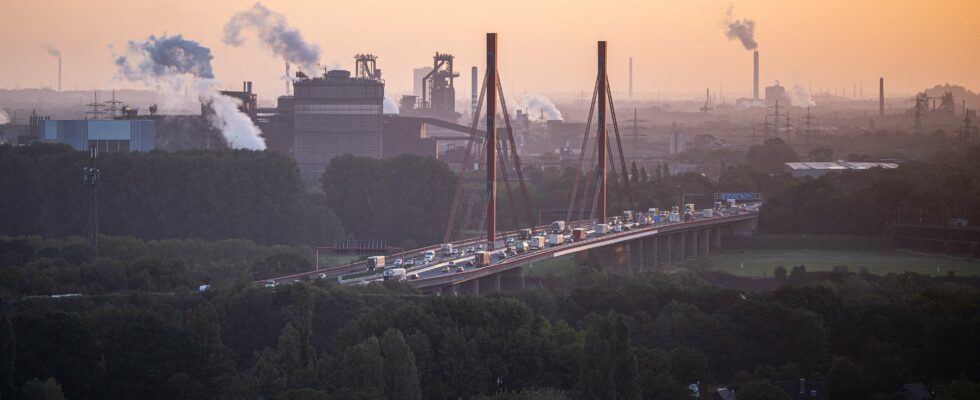This is the story of an unloved, sometimes criticized, often misunderstood mechanism. It has been nearly 20 years since the European Union adopted a CO2 allowance trading system (EQS). The principle: a market on which companies can trade CO2 emission permits to put a cost on carbon and promote the greening of key sectors. Almost two decades later, the system is still in place, and has proven its effectiveness. “Despite its imperfect beginnings, the market has proven its robustness and its ability to weather economic and political crises, and it has become a key tool for the decarbonization of the European Union,” notes Mirabelle Muûls, professor at Imperial College Business School in London. In an article titled “Does carbon pricing mitigate climate change?”, the economist looked at the first years of the implementation of the SEQ. The study shows that during the first eight years, manufacturing industries in France reduced their emissions by 15%, without losing competitiveness.
The ravages of the American Inflation Reduction Act
Thanks to the confidential database of INSEE and the Secure Data Access Center, the authors of the study were able to analyze the information of the companies that consumed the most energy between 1996 and 2012. “This allowed us to measure the emissions of each company, and to compare the results of those that entered the carbon market, and those that were not included in it,” explains the economist. According to this work, the finding is clear: not only do companies taking part in the quota exchange system reduce their emissions, but this does not affect economic health or employment. “We realized with this study that it is not only the fact of receiving free quotas that moves companies towards decarbonization, but also the fact of having given a value to carbon that encourages them to integrate this variable into their industrial processes and investments,” emphasizes Mirabelle Muûls.
Since its inception, the emissions of companies included in the SEQ – just over 10,000 of which are part of it – have fallen by 47% according to the European Commission. But will this be enough to save the system in an increasingly explosive international context, wonders Christian Gollier, Director General of the Toulouse School of Economics. Over the recent period – not taken into account in the study – the implementation of the Inflation Reduction Act has created a huge competitiveness problem between the two sides of the Atlantic. On the one hand, European manufacturers have to pay to go green. They buy emission permits at a price of 75 euros per tonne of CO2 avoided, which represents a 20 to 25% increase in production costs in a sector such as steel. On the other hand, American competitors do not have this financial constraint. They even receive public money to decarbonise!
This untenable situation is forcing Europe to question itself. “We have seen a backlash in the recent period. Suddenly, we are saying to ourselves that the stick method – the one followed by Europe – is not the right one. I am very worried about the future of the carbon pricing mechanism with the new Commission that is going to be installed”, indicates Christian Gollier. However, the economist believes in the virtues of this system. “If we had a higher and more credible carbon tax in the long term, we would have a lot more green innovation in Europe. Enough to create very competitive business ecosystems in decarbonized sectors”. However, this is not really what is happening on the ground. For example, a carbon price of at least 200 euros per tonne of CO2 would be needed for steelmakers to seriously start greening their processes, by switching from coal to hydrogen.
Increase in price at the pump
This shift is still possible, however. From 2027, the system will enter a new phase with the creation of a second emissions quota market that will include two key sectors for the transition: transport and construction. This time, companies in the sectors concerned will not benefit from free quotas to cover their carbon emissions, which should ultimately make it possible to increase the price of CO2… and make the market even more efficient. According to the Norwegian carbon market research firm Veyt, CO2 emissions from the sectors covered by SEQ2 could thus be reduced by 28% between 2022 and 2030.
But these are theoretical results. “There would need to be a clear political will to truly reduce the number of permits available on the quota market,” sums up Christian Gollier. Does this desire exist at the European level after the June elections? It is doubtful. Especially since another problem is looming on the horizon. With a high price of CO2 on the markets, companies should logically pass on part of this additional cost to consumers. Veyt estimates that the price of a liter of diesel could increase by 14 cents at the pump in 2027, and up to 54 cents in 2031, as new measures are gradually implemented. In 2018, the prospect of an increase of 3 cents for gasoline and 6 cents for diesel was enough to trigger the anger of the yellow vests.
.
